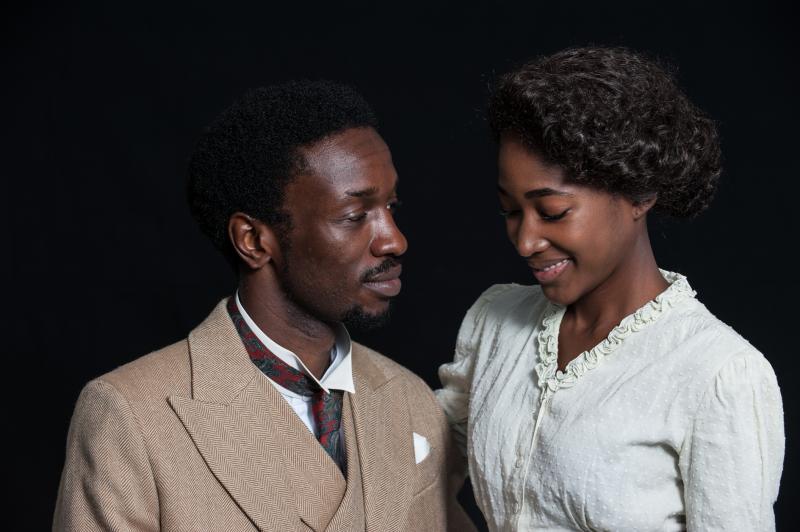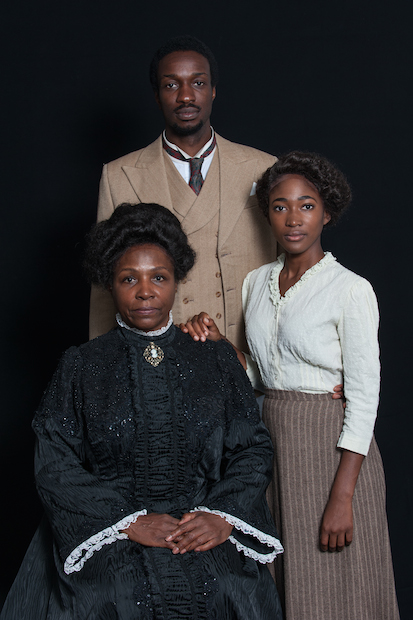Rachel, Finborough Theatre | reviews, news & interviews
Rachel, Finborough Theatre
Rachel, Finborough Theatre
Revival of the first-ever play by an African-American women struggles to impress

As a political act, the first performance of Angelina Weld Grimké’s Rachel in 1916 is exceptionally important. It was staged in Washington DC by the drama committee of the National Association for the Advancement of Colored People, and was the first play by an African-American woman ever to be professionally produced (as well as one of the first to feature an all-black cast).
As drama, though, it does not quite measure up. The themes it features - segregation, racism, insidious intolerance - are undoubtedly powerful and too-little discussed on the stage. Yet the play’s dialogue is plodding, often awkward and over-full of exposition, and the structure is repetitive and sterile.
Seeing the play revived now is a strangely conflicting experienceThe action takes place in the living room of Mrs Loving (Miquel Brown, pictured below left with Zephryn Taitte and Adelayo Adedayo), a dressmaker who lives in a northern American city in the early 20th century. At the outset, all is positive, despite their relative poverty - her two children, Rachel and Tom, are well-educated and hopeful of their prospects, and she has enough work to keep them comfortably. But on the ten-year anniversary of her husband’s death, she decides to tell her children the truth: their father and half-brother were murdered by a white mob in a southern town. The long narration of the terrible story is compelling, but the characters’ reaction to it is typical of the weak dialogue in this play - after hearing how his father died, Tom absurdly leaps up and yells “I see red!” to indicate his anger. The play is so word-heavy that there is very little space left for any really emotional acting - it feels long, too, mostly because the characters are constantly delivering long, expository monologues to each other.
 The teenage Rachel, from whom we have already heard a lengthy, quasi-religious exhortation to her future calling as a mother, is affected differently by her mother's revelation. She reasons that if her half-brother grew up only to be killed, there must be thousands of brown babies all across the south who risk the same fate - wouldn’t it be better if they had never been born?
The teenage Rachel, from whom we have already heard a lengthy, quasi-religious exhortation to her future calling as a mother, is affected differently by her mother's revelation. She reasons that if her half-brother grew up only to be killed, there must be thousands of brown babies all across the south who risk the same fate - wouldn’t it be better if they had never been born?
This idea grows and twists inside her as she gets older, adopts an orphaned child from elsewhere in their apartment block, fails to get a job because of endemic racism (even in their apparently liberal northern city), and is courted by a Mr Strong (Zephryn Taitte). Indeed, the play’s dark final scene, where Rachel’s preoccupation eventually resurfaces, is the only really riveting bit.
Adelayo Adedayo as Rachel is at the centre of the action and, although her character is required to do endless dishing up of food and clearing of plates, manages to sketch her transition from idealism to despair pretty well. With so many monologues to deliver and listen to in turn, though, it’s hard to find any depth in any of the other characters, despite stalwart efforts from the rest of the cast. It is worth saying, though, that the child actors manage extremely well with such a dense script - little Jimmy got most of the few laughs for his antics.
This is the European Premiere of Rachel’s revival, having been rediscovered by Finborough Theatre Artistic Director Neil McPherson, and is presented as part of Black History Month. Seeing it now is a strangely conflicting experience. Part of the reason it was staged in 1916 was as a response to a recent film, The Birth of a Nation, which glorified the Ku Klux Klan and celebrated racism. As a document of a terrible oppression and a rare creative work by a woman, it is utterly worthwhile. But as a play, it lacks the verve and energy required to capture the imagination.
rating
Explore topics
Share this article
The future of Arts Journalism
You can stop theartsdesk.com closing!
We urgently need financing to survive. Our fundraising drive has thus far raised £49,000 but we need to reach £100,000 or we will be forced to close. Please contribute here: https://gofund.me/c3f6033d
And if you can forward this information to anyone who might assist, we’d be grateful.

Subscribe to theartsdesk.com
Thank you for continuing to read our work on theartsdesk.com. For unlimited access to every article in its entirety, including our archive of more than 15,000 pieces, we're asking for £5 per month or £40 per year. We feel it's a very good deal, and hope you do too.
To take a subscription now simply click here.
And if you're looking for that extra gift for a friend or family member, why not treat them to a theartsdesk.com gift subscription?
more Theatre
 Make It Happen, Edinburgh International Festival 2025 review - tutting at naughtiness
James Graham's dazzling comedy-drama on the rise and fall of RBS fails to snarl
Make It Happen, Edinburgh International Festival 2025 review - tutting at naughtiness
James Graham's dazzling comedy-drama on the rise and fall of RBS fails to snarl
 Edinburgh Fringe 2025 reviews: I'm Ready To Talk Now / RIFT
An intimate one-to-one encounter and an examination of brotherly love at the Traverse Theatre
Edinburgh Fringe 2025 reviews: I'm Ready To Talk Now / RIFT
An intimate one-to-one encounter and an examination of brotherly love at the Traverse Theatre
 Top Hat, Chichester Festival Theatre review - top spectacle but book tails off
Glitz and glamour in revived dance show based on Fred and Ginger's movie
Top Hat, Chichester Festival Theatre review - top spectacle but book tails off
Glitz and glamour in revived dance show based on Fred and Ginger's movie
 Edinburgh Fringe 2025 reviews: Alright Sunshine / K Mak at the Planetarium / PAINKILLERS
Three early Fringe theatre shows offer blissed-out beats, identity questions and powerful drama
Edinburgh Fringe 2025 reviews: Alright Sunshine / K Mak at the Planetarium / PAINKILLERS
Three early Fringe theatre shows offer blissed-out beats, identity questions and powerful drama
 The Daughter of Time, Charing Cross Theatre review - unfocused version of novel that cleared Richard III
The writer did impressive research but shouldn't have fleshed out Josephine Tey’s story
The Daughter of Time, Charing Cross Theatre review - unfocused version of novel that cleared Richard III
The writer did impressive research but shouldn't have fleshed out Josephine Tey’s story
 Evita, London Palladium review - even more thrilling the second time round
Andrew Lloyd Webber's best musical gets a brave, biting makeover for the modern age
Evita, London Palladium review - even more thrilling the second time round
Andrew Lloyd Webber's best musical gets a brave, biting makeover for the modern age
 Maiden Voyage, Southwark Playhouse review - new musical runs aground
Pleasant tunes well sung and a good story, but not a good show
Maiden Voyage, Southwark Playhouse review - new musical runs aground
Pleasant tunes well sung and a good story, but not a good show
 The Winter's Tale, RSC, Stratford review - problem play proves problematic
Strong women have the last laugh, but the play's bizarre structure overwhelms everything
The Winter's Tale, RSC, Stratford review - problem play proves problematic
Strong women have the last laugh, but the play's bizarre structure overwhelms everything
 Brixton Calling, Southwark Playhouse review - life-affirming entertainment, both then and now
Nostalgic, but the message is bang up to date
Brixton Calling, Southwark Playhouse review - life-affirming entertainment, both then and now
Nostalgic, but the message is bang up to date
 Inter Alia, National Theatre review - dazzling performance, questionable writing
Suzie Miller’s follow up to her massive hit 'Prima Facie' stars Rosamund Pike
Inter Alia, National Theatre review - dazzling performance, questionable writing
Suzie Miller’s follow up to her massive hit 'Prima Facie' stars Rosamund Pike
 A Moon for the Misbegotten, Almeida Theatre review - Michael Shannon sears the night sky
Rebecca Frecknall shifts American gears to largely satisfying effect
A Moon for the Misbegotten, Almeida Theatre review - Michael Shannon sears the night sky
Rebecca Frecknall shifts American gears to largely satisfying effect
 Burlesque, Savoy Theatre review - exhaustingly vapid
Adaptation of 2010 film is busy, bustling - and bad
Burlesque, Savoy Theatre review - exhaustingly vapid
Adaptation of 2010 film is busy, bustling - and bad

Add comment